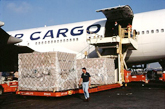 |
The global air freight sector is facing a supply surplus, and airlines around the world are now desperately trying to bring capacity back in line with demand.
Globally freighter capacity rose 2.1 per cent in the first half of the year against a demand contraction of 2.6 per cent, according to the latest figures from IATA (International Air Transport Association), reports London's Flightglobal.
Asia, which has been the engine of growth for the air freight sector for more than 20 years is now beginning to slow, Flightglobal says.
Asian demand fell 7.1 per cent year on year from January to June, while capacity was cut by just 1.7 per cent. In Europe traffic fell 4.3 per cent against a rise in capacity of 1.2 per cent.
Hong Kong's Cathay Pacific has been forced to cut some of its capacity in preparation for the delivery of 10 x 747-8 freighters in the coming years, which it has recently ordered. The airline has also taken delivery of seven new Boeing freighters in the past year. It will also take delivery of another aircraft in October.
To date, Cathay has disposed of a number of 747-400BCFs (Boeing Freight Conversions) that it had received just a few years ago. One of these was scrapped earlier in the year. Another two have been parked, and a further three have been leased out to Hong Kong Airlines.
Air France-KLM is also reportedly looking to take steps to reduce its freighter fleet and that of its subsidiaries, the Flightglobal report said.
Lufthansa Cargo managed to cut its freighter capacity by 13 per cent year on year in July, and it has also reduced its belly capacity by three per cent.
Despite the rather bleak global picture, the article reveals that there is one bright spot in the global airfreight market, the Middle East.
The region saw an increase in air freight demand of 14.8 per cent in the first half of the year compared with an increase in supply of 14 per cent.
Asian Shipper News
|













